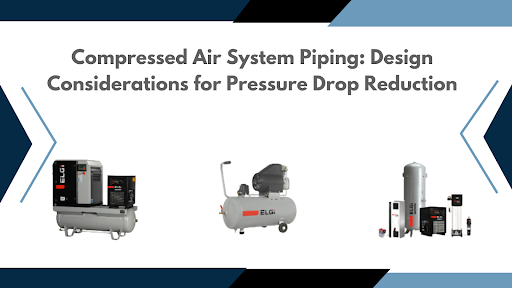
Compressed air is a major source of power in an industrial setting. But to get the most out of your air compressor system, you need to make sure all the ancillaries are well-designed and installed. Piping is an essential support system which plays a huge role in how well your compressed air system performs overall. We at VEMC are a top-notch ELGi dealer in Mumbai and in this blog, we tell you all you need to know about the design consideration of your piping to reduce the pressure drop in your air compressor system.
Factors contributing to pressure drop in piping
- Pipe diameter: This is one of the most obvious factors that impacts the pressure of the compressed air in the piping. Pipe diameter impacts the velocity of the air moving through the pipes. To put it simply, larger the pipe diameter, lesser will be the pressure for a given volume of air.
- Length of the pipe: Longer the pipe, greater will be the friction loss and hence lesser will be the pressure exerted by the compressed air. Pressure drop is thus directly proportional to the pipe length.
- Material: The friction that the moving air particles experience against the walls of the piping also contributes significantly to the drop in pressure. Thus, the material of the piping walls will also determine the extent of pressure drop.
- Fittings: How the piping is designed and fitted is an important factor that affects the drop in pressure. A highly complicated design with too many bends will reduce greater amount of air pressure as compared to a more straightforward one.
Strategies to minimise pressure drop
Now that we have understood what factors cause drop in pressure, let’s take a look at how to avoid or at least minimise it.
- Appropriate pipe sizing: Make sure the pipes are of the right size in terms of both length and diameter. Both long as well as broad pipes can cause unnecessary drop in pressure.
- Avoid unnecessary bends and restrictions: As much as possible, the piping design should be simple and straightforward. Too many bends and restrictions can also cause a drop in pressure due to greater friction.
- Use smooth-surfaced pipes: As mentioned above, friction of air particles with the internal surface of the pipes can also reduce the pressure of the compressed air. It is therefore advisable to use smooth-surfaced material for your piping.
It is quite clear that not only does the power and capacity of your air compressor matter but also the overall system and piping design. With the right piping design and installation, you can maintain optimum performance by reducing drop in pressure.
For more expert advice on your air compressor systems, feel free to call us on 022 43436655 or email us at marketing@vemc.co.in. We at VEMC are the leading ELGi compressor dealer in Mumbai with a wide array of air compressor options available to meet your needs.

